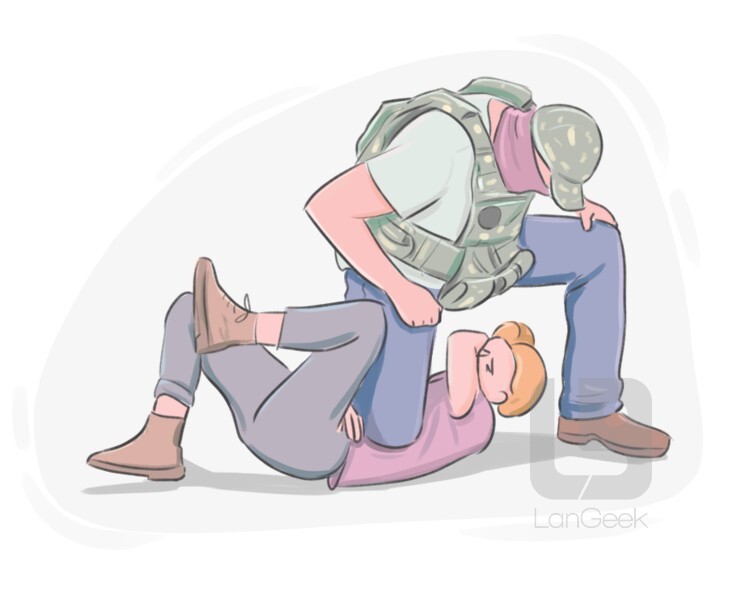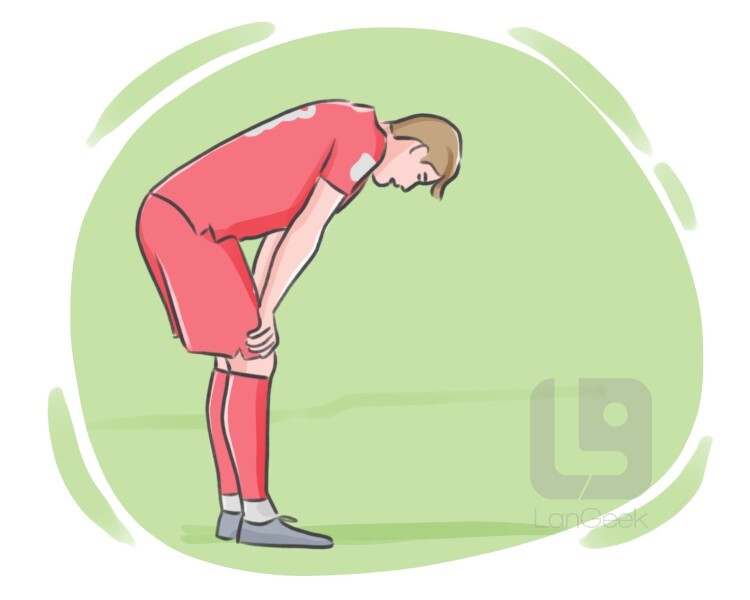Αναζήτηση
Επιλέξτε τη γλώσσα του λεξικού
to beat
01
χτυπώ, δέρνω
to strike someone repeatedly, usually causing physical harm or injury
Transitive: to beat sb

Παραδείγματα
The bully threatened to beat the younger student if he did n't hand over his lunch money.
Ο νταής απείλησε να χτυπήσει τον νεότερο μαθητή αν δεν του έδινε τα λεφτά για το γεύμα.
The police officer was accused of beating the suspect during the arrest.
Ο αστυνομικός κατηγορήθηκε ότι χτύπησε τον ύποπτο κατά τη σύλληψη.
02
νικώ, κερδίζω
to get more points, votes, etc. than the other side, in a game, race, competition, etc. and win
Transitive: to beat a rival

Παραδείγματα
The soccer team managed to beat their opponents with a last-minute goal.
Η ομάδα ποδοσφαίρου κατάφερε να νικήσει τους αντιπάλους της με ένα γκολ στο τελευταίο λεπτό.
She strategized to beat her opponents in the chess tournament and claim victory.
Στρατηγούσε να νικήσει τους αντιπάλους της στο τουρνουά σκακιού και να διεκδικήσει τη νίκη.
03
χτυπώ, ανακατεύω
to repeatedly mix something using a spoon, fork, etc.
Transitive: to beat food ingredients

Παραδείγματα
Beat the eggs until they are fluffy and light in color.
Χτυπήστε τα αυγά μέχρι να γίνουν αφράτα και ανοιχτόχρωμα.
She had to beat the batter for several minutes to remove all the lumps.
Έπρεπε να χτυπήσει το μείγμα για αρκετά λεπτά για να αφαιρέσει όλα τα σβώλους.
04
χτυπώ, δέρνω
to hit something or someone multiple times in succession
Intransitive: to beat on sth
Παραδείγματα
The police had to beat on the door before anyone answered.
Η αστυνομία έπρεπε να χτυπήσει την πόρτα πριν απαντήσει κάποιος.
The drummer began to beat on the drums, filling the room with rhythm.
Ο ντράμερ άρχισε να χτυπά τα ντραμς, γεμίζοντας το δωμάτιο με ρυθμό.
05
χτυπώ, σφυρηλατώ
to form or mold something by hitting or striking it repeatedly
Transitive: to beat solid material | to beat solid material into a shape
Παραδείγματα
The blacksmith beat the hot metal into a sword.
Ο σιδηρουργός κτύπησε το καυτό μέταλλο για να φτιάξει ένα σπαθί.
He carefully beat the silver into a thin, flat sheet.
Προσεκτικά χτύπησε το ασήμι σε ένα λεπτό, επίπεδο φύλλο.
06
χτυπώ, κτυπώ
to produce a rhythmic sound by being struck
Intransitive
Παραδείγματα
The tambourine began to beat in sync with the band ’s melody.
Το ντέφι άρχισε να χτυπά σε συγχρονισμό με τη μελωδία της μπάντας.
The cymbals beat in a loud clash, adding intensity to the song.
Τα πιάτα χτυπούν σε μια δυνατή σύγκρουση, προσθέτοντας ένταση στο τραγούδι.
07
κάνω αντιδρομήσεις, πλέω εναντίον του ανέμου σε ζιγκ-ζαγκ
to sail or navigate a boat or ship in a zigzag course against the wind, tacking back and forth
Intransitive
Παραδείγματα
The captain ordered to beat upwind, though it took much longer to reach their destination.
Ο καπετάνιος διέταξε να πλεύσει ενάντια στον άνεμο, αν και χρειάστηκε πολύ περισσότερο χρόνο για να φτάσουν στον προορισμό τους.
The ship had to beat into the stiff breeze as it made its way towards the coast.
Το πλοίο έπρεπε να κάνει ζιγκ-ζαγκ ενάντια στον δυνατό άνεμο καθώς κατευθυνόταν προς την ακτή.
08
χτυπώ, κτυπώ
to make repeated movements or strikes in the air
Intransitive
Παραδείγματα
The insect 's wings beat rapidly, creating a soft buzzing sound.
Τα φτερά του εντόμου χτυπούν γρήγορα, δημιουργώντας ένα απαλό βουητό.
The helicopter ’s blades beat against the wind, creating a loud hum.
Οι λεπίδες του ελικοπτέρου χτυπούν τον άνεμο, δημιουργώντας ένα δυνατό βουητό.
09
χτυπώ, δέρνω
to exert intense, harsh force or pressure
Intransitive: to beat somewhere
Παραδείγματα
A harsh wind beat against the windows, rattling the panes.
Ένας δυνατός άνεμος χτυπούσε τα παράθυρα, κουνώντας τα τζάμια.
Waves beat against the shore, eroding the sandy beach.
Τα κύματα χτυπούν στην ακτή, διαβρώντας την αμμώδη παραλία.
10
χτυπώ, ψάχνω
to walk or move across an area of land, striking the ground or vegetation to flush out game birds for hunting
Transitive: to beat an area of land
Παραδείγματα
The hunters beat the bushes to drive the pheasants toward the waiting guns.
Οι κυνηγοί χτυπούν τους θάμνους για να οδηγήσουν τους φασιανούς προς τα περιμένοντα όπλα.
They hired a team to beat the fields, hoping to raise some grouse.
Προσέλαβαν μια ομάδα για να χτυπήσουν τα χωράφια, ελπίζοντας να σηκώσουν μερικές αγριόκοτες.
11
ποδοπατώ, σφυρηλατώ
to create or form something by repeatedly stepping, pressing, or driving over it
Transitive: to beat a pathway
Παραδείγματα
The children beat a path through the tall grass as they walked to the river each day.
Τα παιδιά άνοιξαν ένα μονοπάτι μέσα από το ψηλό γρασίδι καθώς περπατούσαν προς το ποτάμι κάθε μέρα.
Over time, hikers beat a trail through the dense forest.
Με το πέρασμα του χρόνου, οι πεζοπόροι άνοιξαν ένα μονοπάτι μέσα από το πυκνό δάσος.
12
χτυπώ, κτυπώ
to create a rhythm or signal by striking something in a repeated pattern
Transitive: to beat an instrument or surface
Παραδείγματα
The drummer beat a steady rhythm to lead the parade.
Ο ντράμερ χτυπούσε ένα σταθερό ρυθμό για να οδηγήσει την παρέλαση.
The conductor beat time with his baton, guiding the orchestra.
Ο μαέστρος χτυπούσε το ρυθμό με τη ράβδο του, καθοδηγώντας την ορχήστρα.
13
χτυπώ, φτερουγίζω
to move the wings up and down, typically as part of flight or in preparation for flight
Transitive: to beat the wings
Παραδείγματα
The bird beat its wings rapidly to take off from the ground.
Το πουλί χτύπησε γρήγορα τα φτερά του για να απογειωθεί από το έδαφος.
As the storm approached, the seagull beat its wings against the strong wind.
Καθώς πλησίαζε η καταιγίδα, ο γλάρος χτυπούσε τα φτερά του ενάντια στον δυνατό άνεμο.
14
χτυπώ, κτυπώ
to create a rhythm or signal by striking something in a repeated pattern
Transitive: to beat a rhythm
Παραδείγματα
The drummer beat a steady rhythm to lead the parade.
Ο ντράμερ χτυπούσε ένα σταθερό ρυθμό για να οδηγήσει την παρέλαση.
The conductor beat time with his baton, guiding the orchestra.
Ο μαέστρος χτυπούσε το ρυθμό με τη ραβδί του, καθοδηγώντας την ορχήστρα.
15
χτυπάω, πάλλω
to pulsate, throb, or beat with regular rhythm
Intransitive
Παραδείγματα
His heart began to beat faster as he approached the stage.
Η καρδιά του άρχισε να χτυπά πιο γρήγορα καθώς πλησίαζε τη σκηνή.
I could feel my heart beat in my chest as I ran the final stretch of the race.
Μπορούσα να νιώθω την καρδιά μου να χτυπά στο στήθος μου καθώς έτρεχα το τελευταίο τμήμα του αγώνα.
16
χτυπώ, παλμολογώ
to make a regular, steady sound or movement
Intransitive
Παραδείγματα
The clock beat softly in the background, filling the quiet room.
Το ρολόι χτυπούσε απαλά στο παρασκήνιο, γεμίζοντας το ήσυχο δωμάτιο.
The metronome beat to keep time for the pianist's practice.
Ο χτύπος του μετρονόμου βοηθά στη διατήρηση του χρόνου για την εξάσκηση του πιανίστα.
17
ξεπεράσω, νικώ
to surpass or outdo someone or something
Transitive: to beat sb/sth
Παραδείγματα
The new model of the car beats the old one in terms of fuel efficiency.
Το νέο μοντέλο του αυτοκινήτου ξεπερνά το παλιό σε ό,τι αφορά την απόδοση καυσίμων.
Her cooking skills beat everyone else at the cooking contest.
Οι μαγειρικές της ικανότητες νίκησαν όλους τους άλλους στο διαγωνισμό μαγειρικής.
18
κουράζω, εξαντλώ
to cause extreme tiredness or weariness in someone
Transitive: to beat sb
Παραδείγματα
The long hike through the mountains really beat us by the end of the day.
Ο μεγάλος πεζοπορικός διαδρομή μέσα από τα βουνά μας κούρασε πραγματικά μέχρι το τέλος της ημέρας.
The intense study sessions before exams can really beat a person.
Οι εντατικές μελέτες πριν από τις εξετάσεις μπορούν πραγματικά να κουράσουν ένα άτομο.
19
μπερδεύω, σαστίζω
to puzzle or confuse someone
Transitive: to beat sb
Παραδείγματα
The complexity of the problem really beat me; I could n’t figure it out.
Η πολυπλοκότητα του προβλήματος πραγματικά με νίκησε· δεν μπορούσα να το καταλάβω.
The sudden disappearance of the ship beats all logic.
Η ξαφνική εξαφάνιση του πλοίου μπερδεύει όλη τη λογική.
20
αποφεύγω, ξεπεράσω
to find a way to avoid or overcome an obstacle, rule, or restriction
Transitive: to beat an obstacle or restriction
Παραδείγματα
She tried to beat the traffic by leaving an hour earlier.
Προσπάθησε να νικήσει την κίνηση φεύγοντας μια ώρα νωρίτερα.
The company found a way to beat the new tax regulations.
Η εταιρεία βρήκε έναν τρόπο να παρακάμψει τους νέους φορολογικούς κανονισμούς.
Beat
01
ρυθμός, χτύπος
a piece of music's or a poem's main rhythm

Παραδείγματα
The drummer sets the beat for the band, establishing the tempo and rhythm of the song.
In electronic dance music, the bassline provides a driving beat that gets people moving on the dance floor.
02
χτύπος, σφυγμός
the rhythmic contraction and expansion of the arteries with each beat of the heart
Παραδείγματα
She felt her heart beat faster after running.
Athletes monitor their heart beat during training.
03
περίπολος, διαδρομή
a regular route for a sentry or policeman
Παραδείγματα
The policeman walked his usual beat downtown.
Each beat is patrolled twice per shift.
04
χορτοφάγος, φυτοφάγος
feeding only on plants
05
αναγωγή, πλεύση ενάντια στον άνεμο
the act of beating to windward; sailing as close as possible to the direction from which the wind is blowing
Παραδείγματα
The sailors completed a long beat up the bay.
A careful beat allowed the yacht to make headway against the wind.
06
χτύπημα, κτύπος
a stroke or blow
Παραδείγματα
He felt the beat of the hammer on the metal.
A beat to the head knocked him backward.
07
χτύπος, ρυθμός
a regular rate of repetition
Παραδείγματα
The clock ticked with a steady beat.
His steps fell in a rhythmic beat.
08
χτύπημα, παλμός
the sound of stroke or blow
Παραδείγματα
The sudden beat of a hammer startled him.
He heard the beat of hooves on the ground.
09
χτύπος, παλμός
a single pulsation of an oscillation produced by adding two waves of different frequencies; has a frequency equal to the difference between the two oscillations
Παραδείγματα
The beat frequency was calculated to be 2 Hz.
Beats occur when two frequencies are nearly identical.
10
χτύπος, πάλμος
the basic unit of time that serves as the foundation for rhythm
Παραδείγματα
Each beat marks a division of the measure.
The composer emphasized the first beat of each bar.
11
μια στιγμή, μια παύση
a moment or pause in a scene where a character experiences a change in emotion or thought, often used to build tension, convey subtext, or advance the story
Παραδείγματα
The actor paused for a beat before delivering the punchline.
A beat in the dialogue conveyed tension.
beat
Παραδείγματα
I was so beat after moving all those boxes.
Ήμουν τόσο ξεμεινασμένος μετά τη μετακίνηση όλων αυτών των κουτιών.
She looked beat after pulling an all-nighter.
Φαινόταν ξεπεσμένη αφού ξενύχτησε όλη τη νύχτα.
02
έχει τέλειο μακιγιάζ, έχει άψογο μακιγιάζ
wearing a full face of makeup, usually applied skillfully and flawlessly
Παραδείγματα
Her face is beat for the party tonight; she looks amazing.
Το πρόσωπό της είναι beat για το πάρτι απόψε; φαίνεται καταπληκτική.
I love how her makeup is beat; every detail is perfect.
Λατρεύω πώς το μακιγιάζ της είναι beat· κάθε λεπτομέρεια είναι τέλεια.
Λεξικό Δέντρο
beaten
beater
beat





























